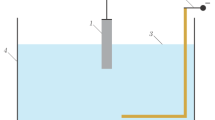Abstract
An electrical discharge between a liquid surface and an electrode positioned above it is considered. A second electrode, which delivers the output from a high-voltage source, is located at the bottom of the vessel containing the liquid. The conditions that must be met by the electrical discharge in order to efficiently initiate reactions in the liquid phase are analyzed. Under these conditions the number of active particles generated by the discharge turns out to depend on the concentration in the liquid of the substance with which the active particles interact. It is shown that for a corona or spark discharge the reactions can occur in a liquid layer 10–20 mm thick and that for specific reactions there exists an optimum value of the electric field at which the energy expenditures on the initiation of the reaction will be minimum.
Similar content being viewed by others
References
D. N. Andreev, Organic Synthesis in Electrical Discharges [in Russian], edited by. A. D. Petrov, Izd. AN SSSR, Moscow-Leningrad (1953), 334 pp.
K. S. Klopovskii, A. S. Kovalev, D. V. Lopaev et al., Fiz. Plazmy 18, 1606 (1992) [Sov. J. Plasma Phys. 18, 834 (1992)].
N. G. Basov, V. A. Danilychev, V. I. Panteleev et al., Dokl. Akad. Nauk SSSR 233, 839 (1977) [Sov. Phys. Dokl. 22, 213 (1977)].
I. P. Vereshchagin, Corona Discharge in Electron-Ion Technology [in Russian], Énergoatomizdat, Moscow (1985), 160 pp.
Yu. S. Akishev, A. A. Deryugin, I. V. Kochetov et al., Fiz. Plazmy 20, 585 (1994).
A. P. Shvedchikov, É. V. Belousova, A. V. Polyakova et al., Khim. Vysokikh Énergii 26, 317 (1992).
A. Hickling, in Modern Aspects of Electrochemistry, No. 6, Butterworths, London (1971), 329 pp.
V. I. Pavlov, Dokl. Akad. Nauk 55, 37 (1947).
A. P. Shvedchikov, É. V. Belousova, A. V. Polyakova et al., Khim. Vysokikh Énergii 27, 63 (1993).
V. F. Kozhinov and I. V. Kozhinov, in Ozonation of Water [in Russian], Stroiidat, Moscow (1974), p. 21.
J. Hoigne, in Process Technology for Water Treatment, edited by S. Stucki, Plenum, New York (1988), p. 121.
Yu. A. Kulagin, L. A. Shelepin, and V. N. Yaryga, Tr. Fiz. Inst. Akad. Nauk 218, 166 (1994).
I. M. Piskarev and A. I. Sevast’yanov, Abstracts of the Sixth International Frumkinsk Symposium “Fundamental Aspects of Electrochemistry” [in Russian], MGU, Moscow (1995), p. 138.
I. M. Piskarev, A. E. Rylova, and A. I. Sevast’yanov, Elektrokhimiya 32, 895 (1996).
I. M. Piskarev and A. I. Sevast’yanov, Second International Congress EKVATEK-96, Moscow (1996), p. 364.
V. V. Skorcheletti, Theoretical Electrochemistry, Gos. Nauchno-Tekh. Izd. Khim. Lit., Leningrad (1959), 87 pp.
Yu. P. Raizer, Gas Discharge Physics [Springer, New York (1997) Nauka, Moscow (1992), 438 pp.].
Yu. S. Akishev, A. A. Deryugin, I. V. Karal’nik et al., Fiz. Plazmy 20, 571 (1994).
I. M. Piskarev, A. E. Rylova, and A. I. Sevast’yanov, NIIYaF MGU Preprint No. 94-13/335 [in Russian], Scientific-Research Institute of Nuclear Physics, Moscow State University, Moscow (1994).
Author information
Authors and Affiliations
Additional information
Zh. Tekh. Fiz. 69, 58–63 (January 1999)
Rights and permissions
About this article
Cite this article
Piskarev, I.M. Choice of conditions of an electrical discharge for generating chemically active particles for the decomposition of impurities in water. Tech. Phys. 44, 53–58 (1999). https://doi.org/10.1134/1.1259251
Received:
Issue Date:
DOI: https://doi.org/10.1134/1.1259251




